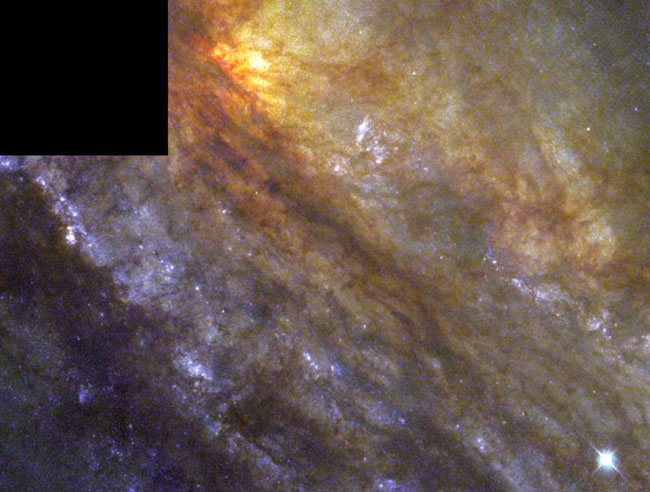NGC 253
| Right Ascension |
00 : 47.6 (h:m)
|
| Declination |
-25 : 17 (deg:m)
|
| Distance |
10000.0 (kly)
|
| Visual Brightness |
7.1 (mag)
|
| Apparent Dimension |
25 x 7 (arc min) |
The 3-16-03 APOD had this beautiful Hubble image of the galaxy's central regions:

Locator chart for NGC 253:

This galaxy's midnight culmination (highest position - due south - in the sky at midnight) is about October 17th. It is only 21 degrees above the horizon (when due south) from my location at 44 degrees north latitude.
There is a very peculiar solar eclipse coming May 31st.

RightWhale, you should see a partial eclipse from your locale. Note that for you it will be around 9 PM Alaska Daylight Time on May 30th.
From Space.com:
A partial eclipse of the Sun surrounded by strange circumstances is on tap for Saturday, May 31 and will be visible in parts of North America, Europe and the Middle East. The event could be quite spectacular at sunrise in Europe, especially in the United Kingdom.Looking directly at the Sun is dangerous, so proper viewing techniques are necessary.
The most impressive aspect of the event will be an annular, or ring eclipse, so named because the Moon’s disk will be too small to completely cover the Sun’s disk. The result is a ring of fire surrounding the black circle of the Moon. It's like a dull penny sitting atop a shiny nickel.
Annular eclipses can occur because the Moon's orbit around Earth is not quite a circle. When the Moon is closer to Earth than average, a total solar eclipse can occur. When it is farther than average, an annular eclipse can result. The annular eclipse will be visible across a sparsely populated swath of Earth from Scotland to the Canadian Arctic.
Strange track
The extreme northern track of the Moon's shadow will likely make this one of the most unusual solar eclipses that will occur in the 21st century.
The antumbra or negative shadow of the Moon – from where the annular phase of eclipse is visible – will strike the Earth at a very oblique angle. In fact, the shadow will actually pass above the North Pole and a bit beyond it before it finally makes contact with the Earth’s surface. As a result of this extraordinary geometry, the antumbra appears to graze the Earth’s surface resulting in a broad, semicircular region that will experience the "ring of fire" effect.
Also, because of this unusual circumstance, instead of moving in a typical west-to-east fashion, as is the case with most solar eclipses, the shadow’s movement will actually run in reverse – from east to west.
Where to see a partial eclipse
Outside of the zone of the annular eclipse, most of Europe, the Middle East, central and northern Asia and northwestern sections of North America will be underneath the Moon’s outer shadow, or penumbra, and will see a partial eclipse. The effect is that of the Moon taking a bite out of the Sun.
The closer one is positioned to the region of visibility of the annular eclipse, the larger the eclipse. Those living in northern and eastern sections of Europe will be in position to see more than 80 percent of the Sun’s diameter eclipsed at, or soon after sunrise. Across parts of central Europe, which includes Ireland, much of England and France, Switzerland and Italy, the peak of the eclipse will have already occurred when the Sun finally comes up above the horizon – nonetheless still making for a most unusual sunrise!
Interestingly, the partial eclipse will also be visible across all of Alaska as well as a swath of northern and western Canada. Depending on where you are located, you might expect to see anywhere from about 40 to 80 percent coverage.
However, adding to the oddities associated with this eclipse, for these "Al-Can localities," since the Moon’s penumbral shadow falls to the east of the International Date Line, local clocks will be set to the previous day: Friday, May 30. Moreover, for these particular locations the eclipse will be occurring not at sunrise, but around the time of sunset.
Where to see the annular eclipse
The region from where the annular phase will be visible takes on an outline resembling a peculiar "D" shape that spans nearly 750 miles (1,200 kilometers), broader than any eclipse path in this century. The antumbra itself, thanks to the grazing angle it makes from the low Sun, projects onto the Earth’s surface as an extremely elongated ellipse. The broad area of visibility includes northern Scotland, encompasses all of Iceland before crossing into central Greenland, before ending in Baffin Bay, Canada.



